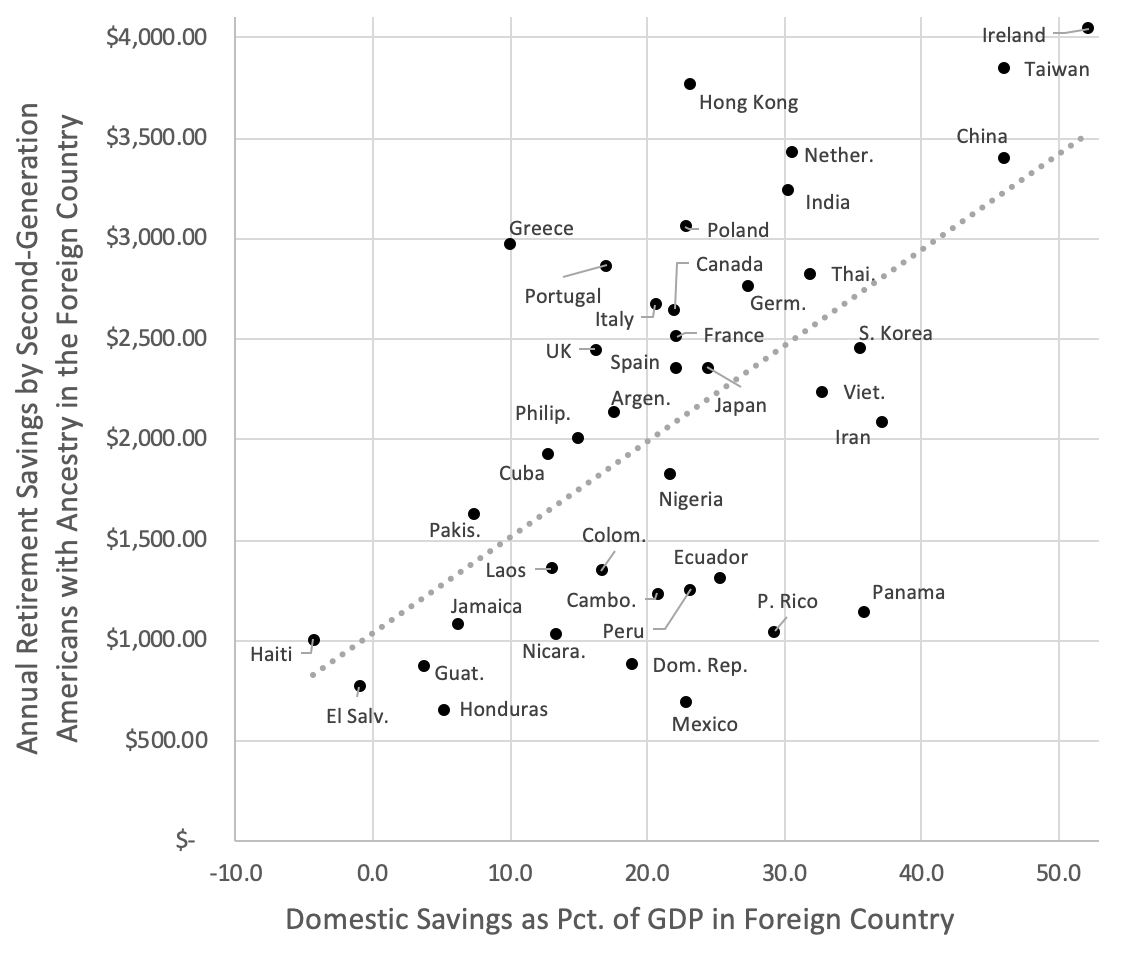Results 1 to 1 of 1
Thread Information
Users Browsing this Thread
There are currently 1 users browsing this thread. (0 members and 1 guests)
-
08-10-2023, 08:31 AM #1
CIS Scholar's Paper on Cultural Persistence Published in Academic Journal
CIS Scholar's Paper on Cultural Persistence Published in Academic Journal
Facebook
Twitter
Reddit
LinkedIn
Email
Copy Link
Print
By Jason Richwine on August 9, 2023
A wide-ranging literature from the fields of economics, history, political science, and sociology shows that the cultural traits brought by immigrants do not always disappear into a melting pot.
Often they persist into the second generation and beyond. Having already written a review of this literature, I have now made my own small contribution to it. “Savings Behavior Among Immigrants and Their U.S.-born Children: A Test of the Culture-Transplant Model” was published last week by the peer-reviewed academic journal Economics Letters.
Although the article is paywalled, I can summarize it here. The motivation comes from a section of The Culture Transplant, in which author Garett Jones notes that the willingness to save money is one of those traits that appears to persist among groups who move to new places.
He cites research from both the UK and Germany showing that the descendants of immigrants have savings behavior reminiscent of their ancestral countries. Without a similar relationship demonstrated in the U.S., however, the finding remains less than robust. My new article aims to fill that gap, using information about retirement contributions from the Current Population Survey (CPS).
Displayed along the horizontal axis of Figure 1 is the national savings rate of foreign countries, while the vertical axis shows the retirement account contributions made by Americans with corresponding ancestries from those countries. These Americans are exclusively second-generation, meaning born in the U.S. with at least one foreign-born parent. (The ancestry of third-generation and higher cannot be identified in the CPS.)
Figure 1. Persistence of Savings Behavior Among Second-Generation Immigrants in the U.S.

Source: Richwine, “Savings Behavior Among Immigrants and Their U.S.-born Children”.

The relative ordering of countries on the horizontal axis is similar to the ordering of American ancestral groups on the vertical axis. For example, South Korea has a higher national savings rate than Nigeria, which in turn has a higher savings rate than Guatemala.
At the same time, Korean Americans save more for their retirements than Nigerian Americans, who save more than Guatemalan Americans. The paper goes on to examine whether the relationship still holds after controlling for factors such as age, sex, income, education, and work experience. It does.
The clear implication is that immigrants bring their savings behavior with them from their home countries and then transmit that behavior to their offspring. The finding is relevant in part because growth-oriented economies require savings and investment.
Selecting immigrants who tend not to save their money could reduce long-term growth in the U.S.
The finding is even more important in a broader sense, however, because it affirms that cultural differences may persist in consequential but non-obvious ways. Even as immigrants achieve the basics of integration in the U.S., such as learning English, they may retain distinctive values that impact their new country for decades to come.
CHART AT LINK BELOW...
https://cis.org/Richwine/CIS-Scholar...ademic-JournalILLEGAL ALIENS HAVE "BROKEN" OUR IMMIGRATION SYSTEM
DO NOT REWARD THEM - DEPORT THEM ALL
Similar Threads
-
Still More Evidence for Cultural Persistence
By Beezer in forum General DiscussionReplies: 1Last Post: 02-23-2023, 09:56 AM -
Journal retracts paper on "chemtrail" threat to San Diego
By JohnDoe2 in forum Other Topics News and IssuesReplies: 1Last Post: 09-29-2015, 10:19 PM -
Harvard Study Finds Fluoride Lowers IQ - Published in Federal Gov't Journal
By AirborneSapper7 in forum Other Topics News and IssuesReplies: 3Last Post: 11-10-2012, 04:43 AM -
Academic Paper in China Sets Off Alarms in U.S.
By AirborneSapper7 in forum Other Topics News and IssuesReplies: 0Last Post: 03-21-2010, 01:24 PM -
A journey of patience and persistence
By jp_48504 in forum illegal immigration News Stories & ReportsReplies: 3Last Post: 05-31-2005, 08:43 AM


 LinkBack URL
LinkBack URL About LinkBacks
About LinkBacks




 Reply With Quote
Reply With Quote


72 Hours Till Deadline: Durbin moves on Amnesty
04-28-2024, 02:18 PM in illegal immigration Announcements